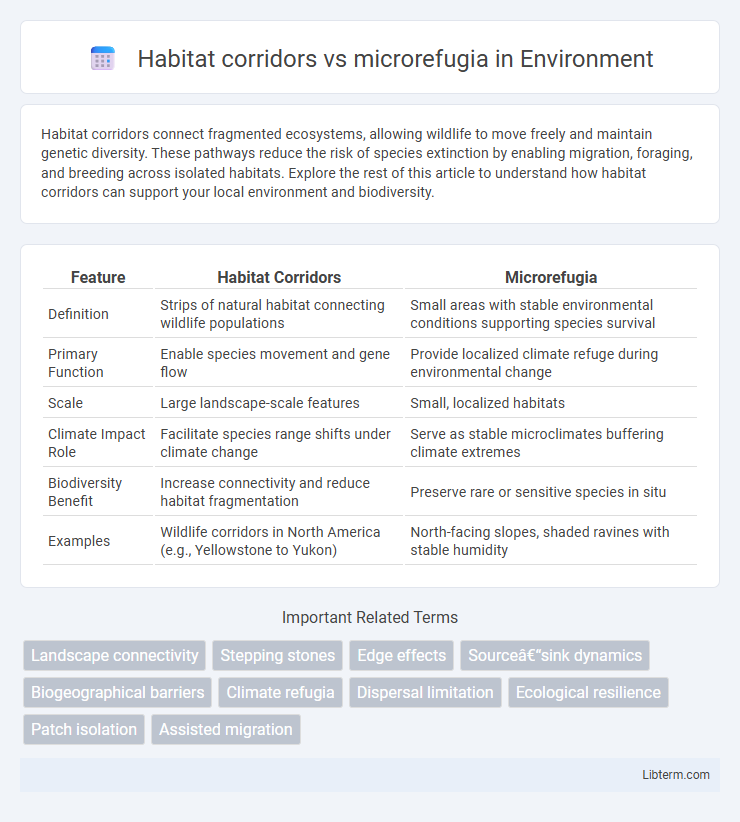Habitat corridors connect fragmented ecosystems, allowing wildlife to move freely and maintain genetic diversity. These pathways reduce the risk of species extinction by enabling migration, foraging, and breeding across isolated habitats. Explore the rest of this article to understand how habitat corridors can support your local environment and biodiversity.
Table of Comparison
| Feature | Habitat Corridors | Microrefugia |
|---|---|---|
| Definition | Strips of natural habitat connecting wildlife populations | Small areas with stable environmental conditions supporting species survival |
| Primary Function | Enable species movement and gene flow | Provide localized climate refuge during environmental change |
| Scale | Large landscape-scale features | Small, localized habitats |
| Climate Impact Role | Facilitate species range shifts under climate change | Serve as stable microclimates buffering climate extremes |
| Biodiversity Benefit | Increase connectivity and reduce habitat fragmentation | Preserve rare or sensitive species in situ |
| Examples | Wildlife corridors in North America (e.g., Yellowstone to Yukon) | North-facing slopes, shaded ravines with stable humidity |
Introduction to Habitat Corridors and Microrefugia
Habitat corridors are natural or restored pathways that connect isolated wildlife populations, enhancing gene flow and species migration amidst fragmented landscapes. Microrefugia are small, climatically stable areas that provide local shelter for species during adverse environmental changes, preserving biodiversity on a fine scale. Both concepts play crucial roles in conservation biology by supporting species survival and adaptive responses to climate change.
Defining Habitat Corridors: Structure and Function
Habitat corridors are linear landscape elements designed to connect isolated patches of habitat, facilitating wildlife movement and gene flow between populations. These corridors function as ecological pathways that support species dispersal, reduce habitat fragmentation, and enhance biodiversity conservation. Their structural components often include native vegetation strips, riparian zones, and stepping stones that provide shelter, foraging resources, and safe passage for diverse fauna.
Microrefugia Explained: Characteristics and Importance
Microrefugia are small, localized habitats that provide suitable microclimatic conditions allowing species to survive during periods of unfavorable climate, playing a critical role in species persistence and biodiversity conservation. These areas often feature unique topographical or vegetative characteristics that buffer against broader environmental changes, making them essential for maintaining genetic diversity and facilitating species' long-term survival. Unlike habitat corridors that connect larger habitats to enable movement and gene flow, microrefugia act as isolated safe havens sustaining populations through climate fluctuations.
Comparative Benefits for Biodiversity Conservation
Habitat corridors enhance landscape connectivity by allowing species migration and gene flow, reducing the risks of population isolation and local extinctions. Microrefugia provide small-scale, stable environmental conditions that support survival of sensitive species during climate fluctuations by offering localized climate buffers. Combining habitat corridors with microrefugia creates a complementary conservation strategy that maximizes biodiversity resilience by facilitating movement and preserving critical refuges within fragmented landscapes.
Role in Climate Change Adaptation
Habitat corridors facilitate species migration and genetic exchange by linking fragmented ecosystems, enhancing biodiversity resilience against climate change impacts. Microrefugia provide localized, stable environments that enable species survival during extreme climatic shifts, acting as critical shelters in rapidly changing habitats. Both strategies support climate change adaptation by maintaining ecological connectivity and offering buffers against habitat loss and temperature extremes.
Connectivity vs. Isolation: Key Ecological Differences
Habitat corridors enhance landscape connectivity by linking fragmented ecosystems, allowing species migration and gene flow that reduce isolation effects and increase biodiversity resilience. Conversely, microrefugia are isolated pockets of favorable environmental conditions that provide safe havens for species during adverse climate changes but do not promote broader connectivity. Understanding these ecological distinctions is crucial for conservation strategies aiming to balance landscape connectivity with localized species protection.
Case Studies: Habitat Corridors in Practice
Habitat corridors have proven effective in enhancing biodiversity by facilitating species movement between fragmented landscapes, as demonstrated in the Yellowstone to Yukon Conservation Initiative, which connects critical habitats across 3,200 kilometers. In contrast, microrefugia serve as small-scale climatic havens allowing species persistence during adverse climate events, but they do not support large-scale dispersal like corridors do. Case studies underscore habitat corridors' role in promoting genetic diversity and species resilience across diverse ecosystems, highlighting their importance in conservation strategies under climate change pressures.
Microrefugia Case Examples and Success Stories
Microrefugia, small climate-stable habitats, have proven critical in conserving biodiversity during environmental changes, with case studies such as the European beech forests in the Alps serving as classic examples of species persistence. Success stories include the preservation of the Edith's checkerspot butterfly in California, where targeted microrefugia management halted local extinctions by maintaining cooler microclimates. These examples highlight how microrefugia complement habitat corridors by offering immediate refuges, supporting species survival amidst climate shifts and habitat fragmentation.
Integrative Approaches: Combining Corridors and Refugia
Integrative approaches combining habitat corridors and microrefugia enhance species resilience by facilitating both movement and localized persistence amid climate change. Corridors enable gene flow and migration across fragmented landscapes, while microrefugia provide stable microhabitats that buffer against environmental extremes. Leveraging spatial modeling and landscape ecology principles optimizes the design of connected networks incorporating refugial sites, maximizing biodiversity conservation under shifting climatic conditions.
Future Perspectives and Conservation Strategies
Habitat corridors enhance species movement and genetic exchange across fragmented landscapes, crucial for climate adaptation and biodiversity preservation. Microrefugia provide localized climate stability, acting as critical sanctuaries for species during environmental extremes, supporting long-term resilience. Integrating corridors with microrefugia in conservation strategies optimizes landscape connectivity and ensures survival of vulnerable species amid accelerating climate change.
Habitat corridors Infographic

 libterm.com
libterm.com